February 2016 LIP of the Month
Magmas erupted during the main pulse of Siberian Traps volcanism were volatile-poor
Svetlana Sibik
Department of Earth Sciences, University of Cambridge, Downing Street, Cambridge CB2 3EQ, UK;
Based in the manuscript Sibik, S., Edmonds, M., Maclennan, J. and Svensen, H. (2015). Journal of Petrology vol. 56, n. 11, 2089–2116, doi: 10.1093/petrology/egv064.
Introduction
The eruption of the Siberian Traps Large Igneous Province (STLIP) at the Permo-Triassic boundary was synchronous with environmental degradation and the largest known mass extinction in the geological record. The volatile emissions associated with these eruptions have been linked to the environmental catastrophe. In order to understand this link, records of the volatile budget of the magmas involved in the Siberian Traps volcanism must be sought and the sources and magnitudes of the fluxes of volatiles estimated (e.g. Self et al., 2005; Black et al., 2012; Svensen et al., 2009; Tang et al., 2013; Iacono-Marciano et al., 2012). The total volatile budget of the STLIP was complex: volatiles were likely sourced from the mantle itself (Sobolev et al., 2009; 2011) and from the crust, including from volatile-rich sediments (Svensen et al., 2009). A large proportion of pyroxenite in the mantle source of the STLIP has been proposed to account for the primary melt to be rich in chlorine and carbon comared to typical mantle-derived primary melts (Sobolev et al., 2009). Most of STLIP magmas on the Craton were emplaced in region of Devonian evaporites, mainly composed of sulfates, and Cambrian evaporites, which are sodium chloride-dominated salts that have been proposed to devolatilise in areas adjacent to sills (Figure 1, Svensen et al., 2009; Zharkov, 1984).
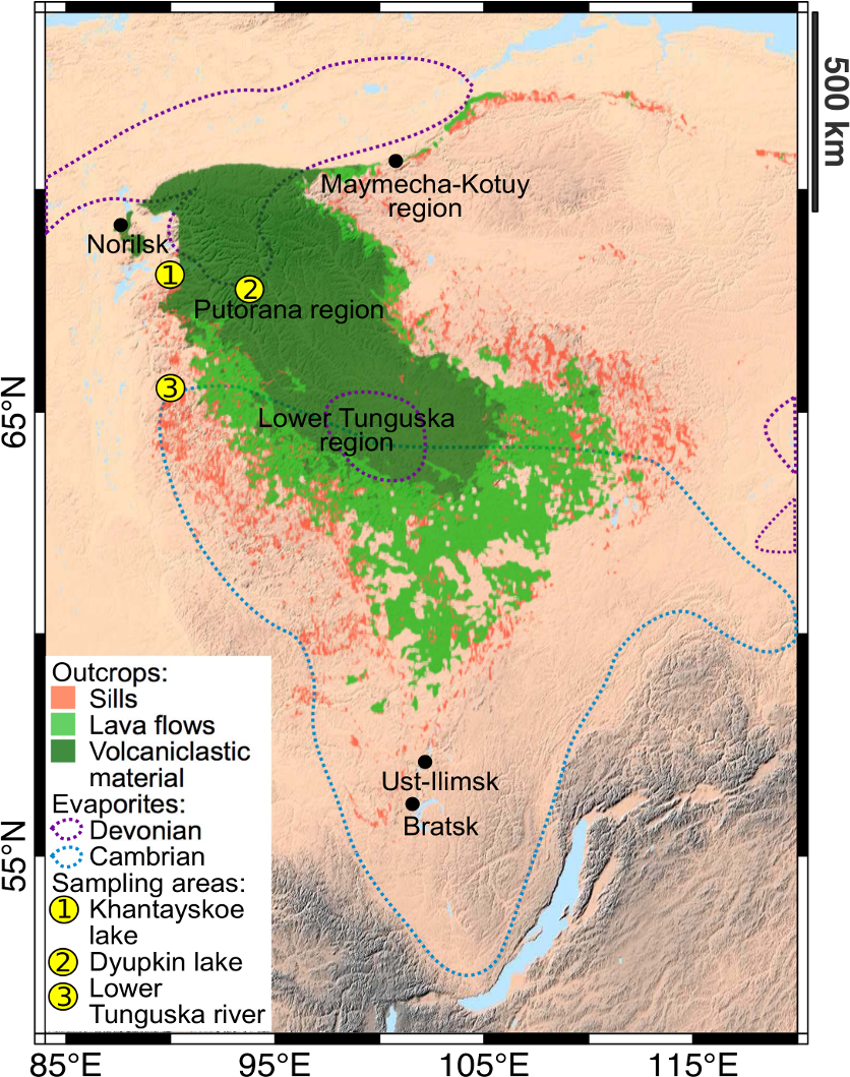
Figure 1. Schematic geological map of the Siberian Craton and the Tunguska Basin, showing the distribution of outcropping sills, lava flows and volcaniclastic deposits (modified from Malich et al., 1974). The distribution of Devonian and Cambrian evaporites is from Zharkov, (1984) and Petrychenko et al. (2005). Sampling areas indicate the locations of samples from which melt inclusions were analysed.
Overall, Siberian Traps magmas are subdivided into those belonging to high or low-titanium series, both of which can be highly and slightly contaminated by continental crust. This study represents the first melt inclusion analysis of the magmas from the low-titanium series. The lavas and sills sampled for this study were not directly emplaced into or erupted onto evaporite deposits (Figure 1); however, the possibility that the magmas could have potentially encountered evaporites at depth is acknowledged. The magmatic rocks analysed here are representative of the vast volumes of tholeiitic lavas erupted as part of the main magmatic pulse, emplaced after the pyroxenite-derived melts analysed by Sobolev et al. (2009). A major aim of this work is to assess whether these magmas were as volatile-rich as the melts inferred to be derived from a mantle source containing recycled oceanic crust which erupted earlier in the STLIP sequence (Sobolev et al., 2009) or whether they have a more depleted signature, consistent with large degrees of melting of peridotite. The trace element and volatile geochemistry of the melt inclusions is used to deconvolve mantle-derived, primary melt compositions and heterogeneity from the effects of crustal contamination, fluid signatures and degassing.
Results
The most primitive melt inclusions were found to be hosted in clinopyroxene phenocrysts Mg# (Mg-number of the host clinopyroxenes (defined by the molar ratio 100*MgO/[MgO+FeO], assuming all iron is ferrous) of ~80. The details of whole-rock geochemistry and mineral composition can be found in Sibik et al. (2015). The melt inclusions described in this study have, in general, higher La/Sm and lower Sm/Yb ratios with La/Yb in the melt inclusions ranging from 0.7 to 9.5 compared with the uncontaminated Gudchikhinsky melt inclusions (which have La/Yb ~5) (Figure 2a). The melt inclusions are highly variable in their large ion lithophile element (LILE) contents, such as Ba, Rb, Sr and K, relative to Primitive Mantle (McDonough & Sun, 1995) and demonstrate distinctive negative Nb and P anomalies (Figure 2b). The melt geochemistry is consistent with relatively large degrees of partial melting of a dominantly peridotite mantle source. A negative Nb anomaly indicates a degree of crustal contamination, but there is no evidence for contamination by volatile-rich evaporites. Enrichment of some of the melts in large ion lithophile elements (Ba, Sr) indicates their interaction with a fluid.
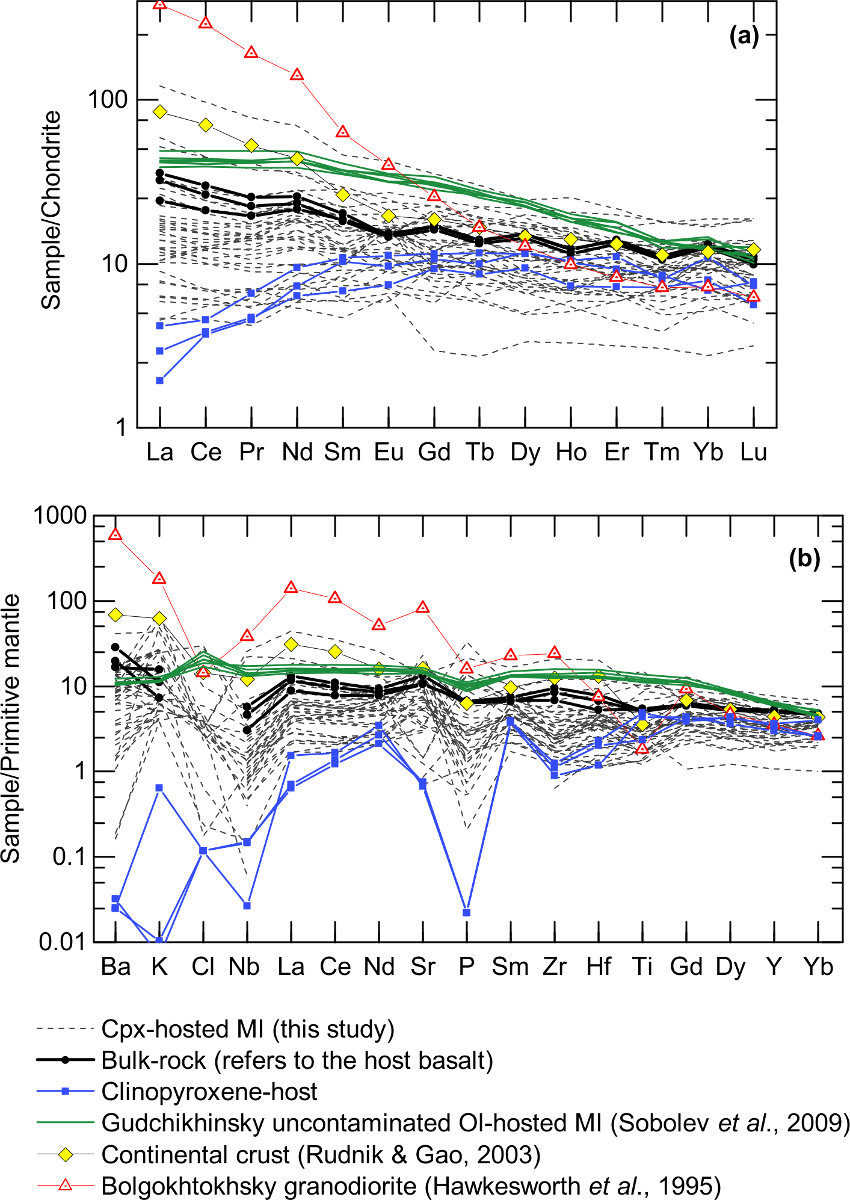
Figure 2. (a) Rare Earth and (b) multi-element patterns of analysed clinopyroxene-hosted melt inclusions from lava flows south of Norilsk, host clinopyroxenes, bulk-rock host basalt from which the clinopyroxene crystals were picked, average continental crust (Rudnick & Gao, 2003), Bolgokhtokhsky granodiorite (Hawkesworth et al., 1995), and the most primitive uncontaminated melt inclusions from the Gudchikhinsky Formation (Sobolev et al., 2009). Concentrations are normalised to the C1-chondrite values (Sun & McDonough, 1989) and Primitive Mantle values (McDonough & Sun, 1995), respectively.
The volatile concentrations in the melt inclusions are mostly low, but variable, with <890 ppm CO2, <510 ppm Cl, <850 ppm F and <510 ppm S (mostly <300 ppm). The melt inclusions from our study are considerably poorer in volatiles than the primary Gudchikhinsky melts (Sobolev et al., 2009), based on which the primary pyroxenite-derived melt was suggested to be poor in sulfur (400 ppm ± 200 ppm) but rich in chlorine (~350-400 ppm) compared to typical mantle-derived primary melts (Sobolev et al., 2009). Sibik et al. (2015) consider the volatile systematics using volatile/refractory trace element ratios. Due to their similar compatibility in the melt, changes in these ratios indicate either mantle source composition variability, crustal contamination or magma degassing, which depletes the volatile concentration. Ratios of the volatile elements to similarly compatible trace elements show a considerable range (Figure 3). F/Nd ratios range from 9 to 79; Cl/K from <0.005 to >0.07 and S/Dy from 6 to 126. Overall, the F/Nd ratio is significantly higher than expected for primitive mantle and MORB, whereas S/Dy is considerably lower than expected. The melt inclusions are poor in sulfur, which does not correlate with any trace element. The Cl/K ratios of the melts are mostly higher than for MORB (Cl/K~0.03; Saal et al., 2002), even though the absolute concentrations of Cl are relatively low. Enrichment in Cl relative to K has also been observed in both olivine- and plagioclase-hosted melt inclusions from Ust-Ilimsk and Bratsk sills (Black et al., 2012) and in the Gudchikhinsky melt inclusions (Sobolev et al., 2009). The F/Nd ratio of the analysed melt inclusions extends up to 80 (Figure 3b), which is far beyond the uniform value of 21 defined by oceanic basalts (Workman et al., 2006) and observed for Siqueiros MORB (Saal et al., 2002). Recent experiments by Rosenthal et al. (2015) suggest that partition coefficients for fluorine are more similar to those of La than Nd. The F/La ratios of the melt inclusions range up to 315, which much higher than for MORB.
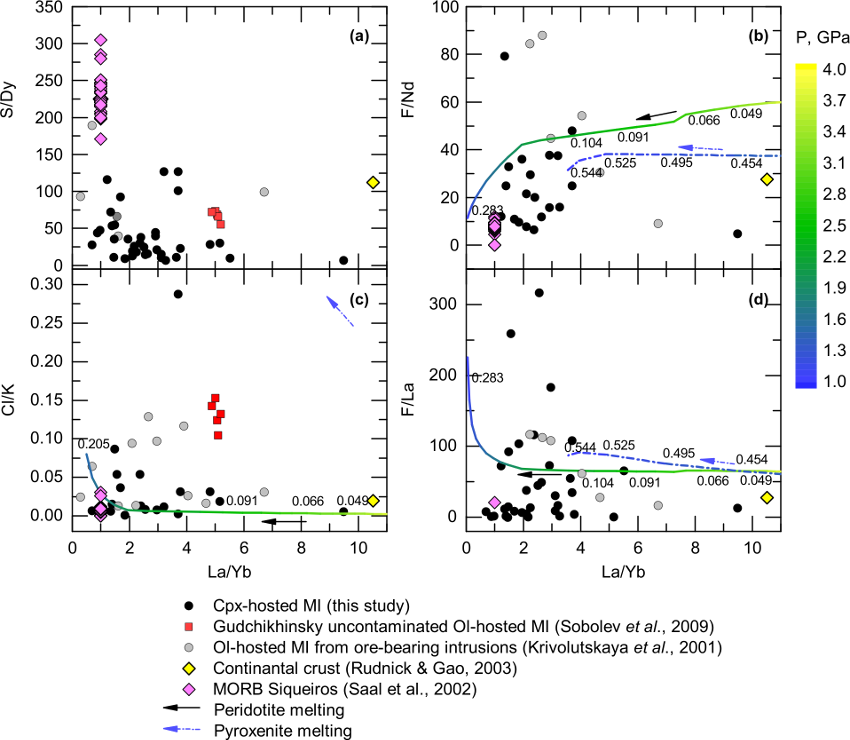
Figure 3. Volatile/trace element ratios versus La/Yb in STLIP melt inclusions (MI) from this and other studies. Data sources: Gudchikhinsky Formation uncontaminated primitive melt inclusions - Sobolev et al. (2009); olivine-hosted MI from ore-bearing intrusions – Krivolutskaya et al. (2001). Shown for comparison are data for Siqueiros MORB (Saal et al., 2002) and average continental crust (Rudnick & Gao, 2003). Model melting curves for peridotite (solid) and pyroxenite (short dash-dot) are colour-coded for pressure, varying from 4 to 1 GPa (see text for details).
Discussion
Here I discuss the factors affecting melt inclusion geochemistry. According to Principal Component analysis, the main control on melt inclusion geochemistry is related to crystal fractionation of pyroxene and plagioclase. The second most important factor is a mantle melting signature that controls the slope of the REE pattern. The trace element compositional profiles of the melt inclusions show overall more depleted REE abundances relative to the “primary” olivine-hosted melt inclusions reported by Sobolev et al. (2009), suggesting that these are melts are derived by large degrees of melting of a source comprised of dominantly peridotite, with a small amount of halogen-rich pyroxenite. The primary melts were relatively depleted in incompatible elements, including volatiles, with the absolute concentrations of sulfur, chlorine and fluorine being lower than in primary melts derived by smaller degrees of melting of peridotite. Halogens are relatively enriched with respect to similar refractory trace elements, however, perhaps as a result of halogen-rich pyroxenite in the source. These volatile-poor magmas may have been widespread across the region during the Siberian Traps eruptions once a pyroxenite component in the mantle source had been exhausted.
Previous studies have considered the influence of lithological variations in mantle source regions on the geochemical composition of the melts being produced (Sobolev et al., 2005, 2007; Herzberg et al., 2006; Shorttle et al., 2011). In order to track the influence of STLIP mantle source heterogeneity (Sobolev et al., 2009, 2011) on the trace element characteristics of the melts we have modelled the melting of two potential mantle source components: peridotite and pyroxenite. The ALPHAMELTS software was used to model the major and trace element composition of accumulated fractional melts produced by isentropic, adiabatic decompression of peridotite and pyroxenite (refer to Sibik et al. (2015) for more details). Variable degrees of partial melting of pyroxenite (>30%) and peridotite (>10%) can broadly account for the chlorine and fluorine variations in the melt inclusions, according to our model predictions (see arrows on Figures 3 b, c, d). The arrows show that the ratios change with progressive partial melting of peridotite and pyroxenite, respectively. Variations in Cl/K, F/Nd and, F/La at a given value of La/Yb lie close to the model peridotite melting curves. The divergence in these ratios gravitates towards the proxenite melting curves. The sulfur concentrations in the melts are low and dominated by a degassing signature.
Fractionation and original heterogeneity within the primary melts of the mantle source has undoubtedly controlled a large amount of the diversity in melt inclusion geochemistry. Crustal contamination is perhaps almost inevitable during prolonged storage of large volumes of basaltic magma in the continental crust and has been shown to be a distinctive and important feature of many other CFBs (Ewart et al., 1998; Hawkesworth et al., 1985; Baker et al., 1996; Devey & Cox, 1987; Brandon et al., 1993). Melt inclusions with a distinctive negative Nb anomaly probably represent melts contaminated by the continental crust (Figure 2b). The role of crustal contamination in the formation of the STLIP has been previously addressed by a number of researchers (Lightfoot et al., 1993; Fedorenko et al., 1996; Reichow et al., 2005). It is crucial to discriminate here between evaporite and siliceous crustal components. Assimilation of evaporites, both sulfate- and salt-dominated, will not influence melt REE enrichment, (e.g. La/Yb ratio) due to the very low concentrations of most REE in evaporites (Figure 4a), but will substantially affect the volatile budget of the magmas (Figures 4 b, c, d). A siliceous crustal component, such as the extremely enriched Bolgokhtoksky granodiorite and also average continental crust, in contrast, will not contribute to the volatile content of melts (and will in fact dilute volatile concentrations) but could promote considerable melt enrichment in LILE and LREE. Crustal assimilation, if it was a key factor in the formation of these melts, would inevitably increase La/Yb ratios, which is not observed in most of the analysed melt inclusions (Figure 2a).
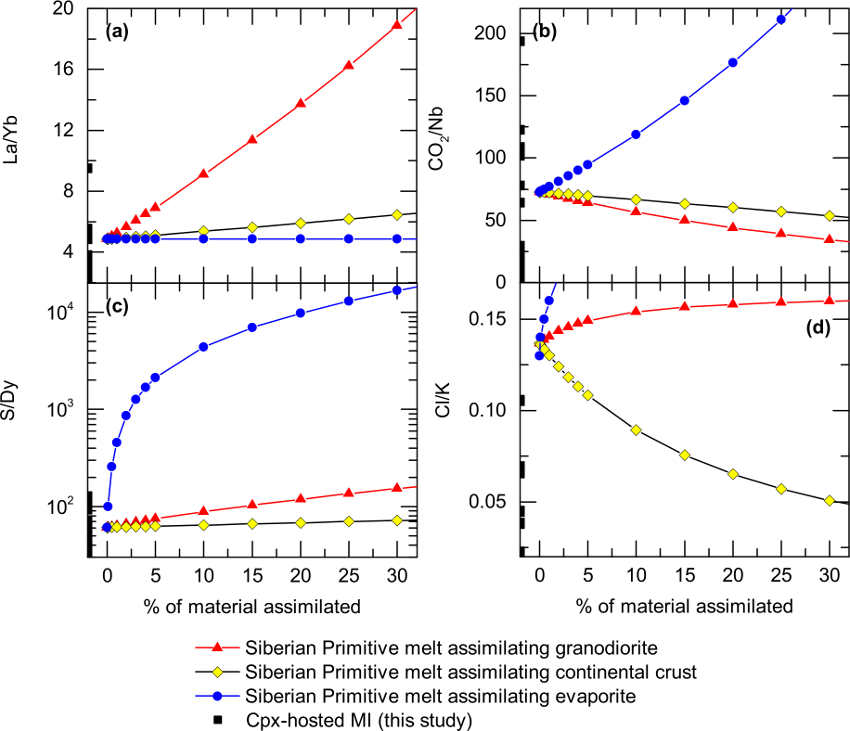
Figure 4. Changes in elemental ratios with assimilation of different crustal components by the reconstructed primitive Siberian Traps melt composition of Sobolev et al. (2009). Ranges of analysed clinopyroxene-hosted melt inclusions from this study are also shown. Data sources: Bolgokhtokhsky granodiorite (Hawkesworth et al., 1995), average continental crust (Rudnick & Gao, 2003), Devonian sulphate-rich evaporite (Pang et al., 2013).
The overarching conclusions of our study are that those STLIP magmas erupted 400-800 ka after the Gudchikinsky Formation magmas (which have been interpreted to be generated by pyroxenite melting) were the result of melting a source that had been depleted substantially in its pyroxenite component. The overall low concentrations of volatiles in the melts, which are consistent with the low concentrations of other incompatible trace elements, are a result of the melts having been formed by relatively large degrees (>15%) of peridotite melting. Relative enrichments in Cl and F with respect to refractory trace elements with similar partition coefficients suggest either that the pyroxenite component of the source, although minor in amount, was extremely halogen-rich; or that the magmas interacted with evaporites in the subsurface (evaporites do not outcrop or subcrop in the region). Other trace element indicators of pyroxenite involvement (e.g. elevated Ti/Y, Gd/Yb) suggest that this is the most likely explanation. Crustal contamination is relatively unimportant for these melts, but the overall effect of a small amount of contamination with siliceous crustal material is to dilute the incompatible elements in the melt, including the volatiles, further.
The volatile contents of the studied melt inclusions are low; furthermore, they are lower than those in the primary melts reported by Sobolev et al. (2009), which were interpreted to have been dominated by pyroxenite melting earlier in the Siberian Traps eruptive sequence. For sulfur and carbon, the low concentrations may be explained by pre-entrapment degassing, which is extremely common in melt inclusions in continental magmas. Chlorine and fluorine, on the other hand, are not expected to be modified significantly by degassing (owing to their greater solubilities in silicate melts (e.g. Webster, 2004)), but their concentrations have certainly been modified by it (eradicating any correlations with other trace elements; Figure 3). These magmas would contribute only around 20-50% of the magmatic gases sulfur dioxide, hydrogen chloride and carbon dioxide to the atmosphere compared to those supplied by the pyroxenite-derived magmas of Sobolev et al. (2009). This equates to ~70 ppm Cl in the analysed melt inclusions versus 350-400 ppm Cl for the primary melt inclusions of Sobolev et al. (2009) and similarly, ~ 270 ppm S versus 350 ppm in the primary melts. The volatiles suppplied to the atmosphere from large melt fractions of peridotite are also relatively small in magnitude compared to those outgassed from magmas intruded into volatile-rich sediments (e.g. Svensen et al., 2009; Black et al., 2012) or from alkaline maymechite magmas (e.g. Black et al., 2012). The reduced gaseous output from the magma does not, however, diminish the importance of degassing of volatile-rich country rocks due to contact metamorphism and volatile release through venting structures (Svensen et al., 2009; Aarnes et al., 2010, 2011).
According to the most accurate existing estimates of the regional distribution of intrusions, lava flows and volcaniclastic material, the total volume of Siberian Traps magmas emplaced on the Siberian Craton is 1.75 million km3 (Vasiliev et al., 2000). Taking into account the lavas and sills subcropping in the West Siberian Basin, the total volume of the STLIP may be up to 4 million km3 (Courtillot et al., 1999; Fedorenko et al., 2000). The volume of magmas not intruded directly into evaporites (but which could have interacted with them at depth) is up to about 590,000 km3 (estimated based on the regional distribution of magmatic rocks in the STLIP reported by Vasiliev et al. (2000) compared to the known distribution of evaporites, Figure 1) comprising nearly one third of the total magma volume on the Craton. The total volume of volatile-rich “pyroxenite-derived” melts of the high-Ti series is less than 25% of the total volume. The magmatic contribution to the volatile budget of the STLIP, if it is assessed based on extrapolating the compositions of volatile-rich melts from Norilsk (Sobolev et al., 2009), the Maymecha-Kotuy Province (Black et al., 2012) and from the southern Cambrian evaporite region in the province (Black et al., 2012, Tang et al., 2013), may thus be highly overestimated. Assimilation of volatile-poor siliceous continental crustal material may have affected large volumes of the low-Ti series magmas which were dominantly derived from a peridotite source (Reichow et al., 2005), which would serve to further dilute their volatile concentrations. It is presumed that the magmas enplaced in the West Siberian Basin were largely peridotite-derived, similar to the samples studied here. This means that about two thirds of the Siberian Trap magmas, taking into account those in the West Siberian Basin, may have been poorer in volatiles compared to the volatile-rich melts analysed by Black et al. (2012) and Sobolev et al. (2009), which should be taken into account in volatile budget estimations.
Figure 5 shows a schematic of the gaseous magmatic output of the STLIP over time, incorporating our interpretation of mantle source evolution. The first intensive volatile ouput, which occurred before the main pulse of magmatism, came from purely pyroxenite-sourced magmas, which were rich in volatiles (particularly chlorine and carbon species; Sobolev et al., 2009, 2011). With time, the pyroxenite component in the heterogeneous mantle source became exhausted and the source eventually became dominated by peridotite. The melt inclusions reported in our current study preserve a signature suggesting a small proportion of pyroxenite component in the source (see discussion above). According to the latest geochronology studies (Song et al., 2012; Burgess et al., 2014; Kamo et al., 2003; Burgess & Bowring, 2015), both the latest Permian and earliest Triassic mass extinctions occurred after the emplacement of magmas derived largely from a pyroxenite mantle source. The volatile output of these early high-Ti magmas was much greater than that of the maymechites and alkaline magmas erupted later in the sequence, which became volatile-rich due to their emplacement in evaporites (Figure 5). The low-Ti basaltic magmas, that comprise most of the STLIP were derived from a depleted peridotite mantle source and emitted a considerably smaller mass burdens of gases. Thus, mantle source heterogeneity created a sequence of volcanism that began with immense emissions of climate-altering gases into the atmosphere (associated with melting a pyroxenite source component) and, with time, gradually evolved into eruptions of more depleted melts with a much lower volatile output.
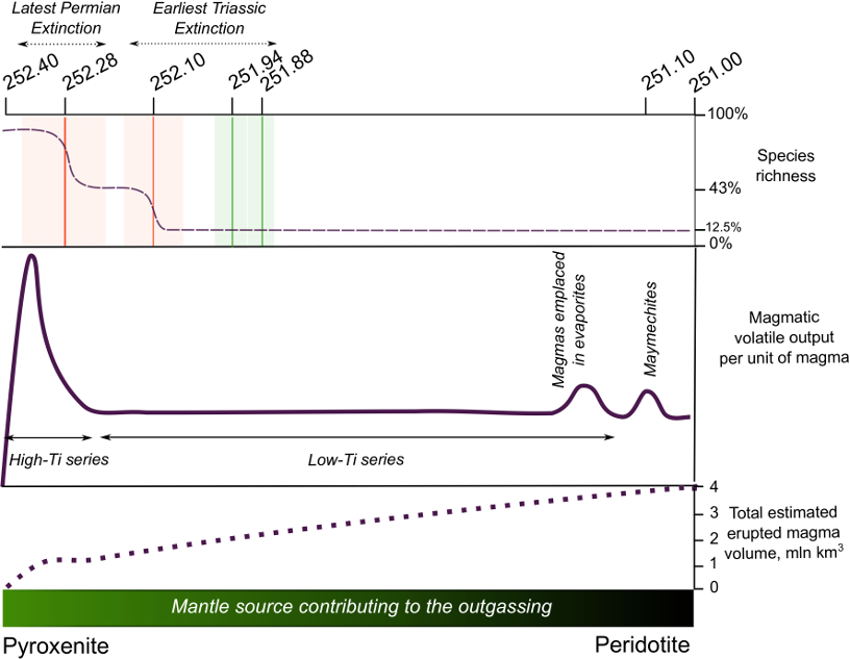
Figure 5. Magmatic contribution to the total volatile output and mantle source evolution over time. The ages of the mass extinctions are from Song et al. (2012) (orange vertical lines with pale orange shaded field representing error bars) and Burgess et al. (2014) (green lines and pale green shaded fields). Ages for the onset and the end of magmatic activity are from Kamo et al. (2003) and for maymechite emplacement from Arndt et al. (1998). High-Ti series magmas comprise less than 1 million km3, which is less than a quarter of the total magma volume. The onsets of both the latest Permian and the earliest Triassic mass extinctions occur after the emplacement of high-Ti pyroxenite-derived chlorine- and carbon-rich magmas. Two thirds of STLIP magma volume were emplaced before or during the extinction (Burgess & Bowring, 2015).
Conclusions
The present study was designed to determine the effect of intrinsic mantle source heterogeneity on the compositions of the Siberian Trap LIP magmas and their volatile outputs. It has been shown that sills and lava flows erupted to the south-east of Norilsk were formed from melts that were subject to differentiation, a small amount of crustal contamination, interaction with crustal fluids and degassing (of carbon and sulfur species). Despite all of these overlain processes, evidence for the mixing of melts derived from differing degrees of melting of a heterogeneous mantle source is preserved. Moreover, this is the second most important parameter controlling the compositional variability of the melts after fractional crystallisation. Mixing of melts derived from variable degrees of melting of peridotite containing a small amount of halogen-rich pyroxenite can account for most of the geochemical features observed in the melt inclusion data set. Overall, the melts are more volatile-poor than those reported from the Gudchikhinsky Formation by Sobolev et al., (2009) and from the Bratsk and Ust-Ilimsk sills by Black et al. (2012). In the former case it is the result of both an increased proportion of peridotite in the source and a significant amount of dilution by assimilation of volatile-poor continental crust, whereas in the latter it is due to a lack of contamination by evaporites. We suggest that these volatile-poor magmas may have been widespread across the Siberian Craton and that the overall volatile budget of the Siberian Traps Large Igneous Province may have been previously overestimated. More accurate estimates of the magmatic contribution to the total volatile budget require careful asessment of the overall volumes of volatile-rich melts, including those sourced from pyroxenite and those emplaced into volatile-rich sediments.
Click to open/close ReferencesReferences
Arndt, N., Chauvel, C., Czamanske, G. & Fedorenko, V. (1998). Two mantle sources, two plumbing systems: tholeiitic and alkaline magmatism of the Maymecha River basin, Siberian flood province. Contributions to Mineralogy and Petrology 133, 297-313.
Baker, J. A., Thirwall, M. F. & Menzies, M. A. (1996). Sr-Nd-Pb isotopic and trace element evidence for crustal contamination of plume-derived flood basalts: Oligocene flood volcanism in western Yemen. Geochimica et Cosmochimica Acta 60, 2559-2581.
Black, B. A., Elkins-Tanton, L. T., Rowe, M. C. & Peate, I. U. (2012). Magnitude and consequences of volatile release from the Siberian Traps. Earth and Planetary Science Letters 317-318, 363-373.
Brandon, A. D., Hooper P. R., Gole, G.G. & Lambert, R. J. (1993) Evaluating crustal contamination in continental basalts: the isotopic composition of the Picture Gorge Basalt of the Columbia River Basalt Group. Contributions to Mineralogy and Petrology 114, 452-464.
Burgess, S. D., Bowring, S., & Shen, S.-Z. (2014), High-precision timeline for Earth’s most severe extinction. Proceedings of the National Academy of Sciences 111, 9, 3316–3321.
Burgess, S. D. & Bowring, S. (2015) High-precision geochronology confirms voluminous magmatism before, during, and after Earth’s most severe extinction. Science Advances 1:e1500470.
Courtillot, V., Jaupart, C., Manighetti, I., Tapponnier, P. & Besse, J. (1999). On causal links between flood basalts and continental breakup. Earth and Planetary Science Letters 166, 177-195.
Devey, C. W. & Cox, K. G. (1987) Relationship between crustal contamination and crystallization in continental flood basalt magmas with special reference to the Deccan Traps of the Western Ghats, India. Earth and Planetary Science Letters 84, 59-68.
Ewart, A., Milner, S. C., Armstrong, R. A. & Duncan, A. R. (1998). Etendeka Volcanism of the Goboboseb Mountains and Messum Igneous Complex , Namibia . Part I : Geochemical Evidence of Early Cretaceous Tristan Plume Melts and the Role of Crustal Contamination in the Parana-Etendeka CFB. Journal of Petrology 39, 191-225.
Fedorenko, V. A., Lightfoot, P. C., Naldrett, A. J., Czamanske, G. K., Hawkesworth, C. J., Wooden, J. L. & Ebel, D. S. (1996). Petrogenesis of the Flood-Basalt Sequence at Noril'sk, North Central Siberia. International Geology Review 38, 99-135.
Hawkesworth, C. J., Lightfoot, P. C., Fedorenko, V. A., Blake, S., Naldrett, A. J., Doherty, W. & Gorbachev, N. S. (1995). Magma differentiation and mineralisation in the Siberian continental flood basalts. Lithos 34, 61-88.
Herzberg, C. (2006). Petrology and thermal structure of the Hawaiian plume from Mauna Kea volcano. Nature 444, 605-609.
Iacono-Marziano, G., Gaillard, F., Scaillet, B., Alexander, G. & Arndt, N. T. (2012). Extremely reducing conditions reached during basaltic intrusion in organic-bearing sediments. Earth and Planetary Science Letters 357-368, 308-318.
Kamo, S. L., Czamanske, G. K., Amelin, Y., Fedorenko, V. A., Davis, D. W. & Trofimov V. R. (2003). Rapid eruption of Siberian £ood-volcanic rocks and evidence for coincidence with the Permian-Triassic boundary and mass extinction at 251 Ma. Earth and Planetary Science Letters 214, 75-91.
Krivoluskaya, N. A. (2001). Magmatic inclusions in olivines from intrusions of the Norilsk’s Region, Northwestern Platform: Evidence for Primary melts. Doklady Earth Sciences 381A, 1047–1052.
Lightfoot, P. C., Hawkesworth, C. J., Hergt, J., Naldrett, A. J., Gorbachev, N. S., Fedorenko, V. A. & Doherty, W. (1993). Remobilisation of the continental lithosphere by a mantle plume: from picritic and tholeiitic lavas of the Noril'sk District, Siberian Traps, Russia. Contributions to Mineralogy and Petrology 114, 171-188.
Malich, N. S., Tazihin, N. N., Tuganova, E. V., Bunzen, E. A., Kulikova, N. G. & Safonova, I. V. (1974). Map of geological formations of the Siberian platform cover (1:1 500 000). Malich, N.S. (Ed.), All-Union Research Geologic Institute (VSEGEI). Leningrad.
McDonough, W. F. & Sun, S. (1995). The composition of the Earth. Chemical Geology 120, 223-253.
Pang, K.-N., Arndt, N., Svensen, H., Planke, S., Polozov, A., Polteau, S., Iizika, Y. & Ching, S.-L. (2013) A petrologic, geochemical and Sr–Nd isotopic study on contact metamorphism and degassing of Devonian evaporites in the Norilsk aureoles, Siberia. Contributions to Mineralogy and Petrology 165, 683-704.
Petrychenko, O. Y., Peryt, T. M. & Chechel, E. I. (2005). Early Cambrian seawater chemistry from fluid inclusions in halite from Siberian evaporites. Chemical Geology 219, 149-161.
Reichow, M. K., Saunders, A., White, R., Al'Mukhamedov, A. & Medvedev, A. (2005). Geochemistry and petrogenesis of basalts from the West Siberian Basin: an extension of the PermoTriassic Siberian Traps, Russia. Lithos 79, 425-452.
Rosenthal, A., Hauri, E. H. & Hirschmann, M. M. (2015). Experimental determination of C, F, and H partitioning between mantle minerals and carbonated basalt, CO2/Ba and CO2/Nb systematics of partial melting, and the CO2 contents of basaltic source regions. Earth and Planetary Science Letters 412, 77-87.
Rudnick, R. L. & Gao, S. (2003) Composition of the continental crust. Treatise on Geochemistry 3, 1-64
Self, S., Thordarson, T. & Widdowson, M. (2005). Gas Fluxes from Flood Basalt Eruptions. Elements 1, 283-287.
Shorttle, O. & Maclennan, J. (2011). Compositional trends of Icelandic basalts: Implications for short-length scale lithological heterogeneity in mantle plumes. Geochemistry, Geophysics, Geosystems 12, 11, doi:10.1029/2011GC003748.
Sobolev, A. V., Arndt, N. T., Krivolutskaya N. A., Kuzmin, D. Y. & Sobolev, S. V. (2015). The origin of gases that caused Permo-Triassic extinction. In ed. Schmidt, Fristad, K. E., Elkins-Tanton. L. T. (ed.) Volcanism and Global Environmental change. Cambridge University Press, 147-163.
Sobolev, A. V., Krivolutskaya, N. A. & Kuzmin, D. V. (2009). Petrology of the parental melts and mantle sources of Siberian trap magmatism. Petrology 17, 253-286.
Sobolev, S. V., Sobolev, A. V., Kuzmin, D. V., Krivolutskaya, N. A., Petrunin, A. G., Arndt, N.T., Radko, V.A. & Vasiliev, Y. R. (2011). Linking mantle plumes, large igneous provinces and environmental catastrophes. Nature 477, 312-316.
Song, H., Wignall, P. B., Tong, J. & Yin, H. (2012). Two pulses of extinction during the
Permian–Triassic crisis. Nature Geoscience 6, 52-56.
Sun, S. & McDonough, W. F. (1989). Chemical and isotopic systematics of oceanic basalts: implications for mantle composition and processes. Geological Society, London, Special Publications 1, 313-345.
Svensen, H., Planke, S., Polozov, A. G., Schmidbauer, N., Corfu, F., Podladchikov, Y. Y. & Jamtveit, B. (2009). Siberian gas venting and the end-Permian environmental crisis. Earth and Planetary Science Letters 277, 490-500.
Tang, Q., Zhang, M., Li, C., Yu, M. & Li, L. (2013). The chemical compositions and abundances of volatiles in the Siberian large igneous province: Constraints on magmatic CO2 and SO2 emissions into the atmosphere. Chemical Geology 339, 84-91.
Vasiliev, Y. R., Zolotukhin V. V., Feoktistov G.D. & Prusskaya S. N. (2000). Evaluation of the volume and genesis of Permo-Triassic Trap magmatism on the Siberian Platform. Russian Geology and Geophysics 41, 1696-1705.
Webster, J. D. (2004). The exsolution of magmatic hydrosaline chloride liquids. Chemical Geology 210, 33–48.
Workman, R. K., Hauri, E., Hart, S. R., Wang, J. & Blusztajn, J. (2006). Volatile and trace elements in basaltic glasses from Samoa: Implications for water distribution in the mantle. Earth and Planetary Science Letters 241, 932–951.
Zharkov, M. A. (1984). Paleozoic Salt Bearing Formations of the World. Springer, Berlin.